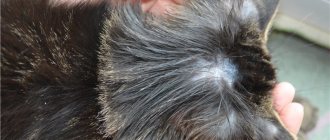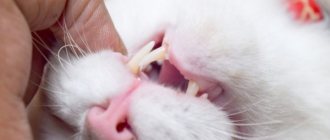The vet talks about the problem!
Have you noticed dry scabs or flaky spots on your pet's skin? Or maybe you're anxiously examining the hard red nodules under your pet's fur? What it is and how to deal with it – we will tell you in this article.
Nowadays, most cats live in the artificial environment of apartments and houses. They eat dry food (check out the good ones), sleep on the couch, look out the window and have virtually no contact with the outside world. It would seem: excellent conditions for a long life without disease.
But in reality, the opposite happens: furry friends become more susceptible to infections and parasites, and they develop allergies.
Many of the diseases that domestic cats suffer from include skin rashes of various shapes, colors and locations as one of the symptoms.
In this article we will tell you about what could cause the appearance of dry sores on the skin of a cat, how to diagnose it and, finally, how to treat the identified disease.
The cat has scabs on its body: Preface
As a rule, domestic cats, like wild cats, live on their own and do not particularly like it when their owners invade their lives and personal space. The owner’s task is to feed and clean the litter box, but this is only in the opinion of the cats themselves.
In fact, owners are always concerned about the health of their cats. But spotting skin problems is more difficult than in dogs. Cats, unlike dogs, are not washed every day after a walk, and are brushed only during the period of shedding and long-haired pets.
Therefore, dermatological problems in cats are most often noticed in an advanced form. We will talk further about why a cat has scabs on its body.
Watch the video: Is your cat itching? Causes of itching - advice from a veterinarian
What causes feline dermatitis?
What causes feline dermatitis? Allergies themselves are not caused by scabs on cats in the area of the back, neck and at the base of the tail, but by the cat’s focused attention on getting rid of allergies. The more persistently a cat scratches, licks and bites itself, and the longer the condition progresses, the more these telltale scabs will form. When it comes to scabs on cats, scratching the scab clears the way for further secondary infections, usually caused by harmless bacteria that live on cats.
Rashes and lesions have begun to appear, and they arise from a number of possible factors. Things that can cause these allergic reactions and cause lumps and scabs in cats include:
- Materials in new bedding, carpets, rugs or other home furnishings
- Ingredient or ingredients in cat food
- Seasonal allergens such as pollen
- Common household chemicals, including cat shampoo
- Mites, sudden proliferation of ear mites or Cheyletiosis (Cheiletiosis, Cheyletiellosis) (“walking dandruff”)
- Fleas and flea bites
By far the most common cause of miliary dermatitis in cats and the scabs in cats that accompany this condition is a flea bite.
The cat is itchy and covered in sores: Diseases
Flea dermatitis
The first and most important cause of all dermatological problems is fleas. Despite the fact that cats do not walk, do not go outside or even into the entrance, they must be treated for fleas as regularly as dogs.
Since fleas most often live under floors, in furniture, under skirting boards and thresholds, and they only come to the animal to dine. When we see fleas on a cat’s body with the naked eye, this is an extreme degree of infection.
The main signs of allergic flea dermatitis are:
- various wounds, sores, scabs on the cat’s body;
- active licking. It is one of the ways cats “scratch”;
- frequent scratching of the entire body.
What should be done in this case? Carry out regular antiparasitic treatments with high-quality products. These can be drops applied to the withers: Bravecto , Inspector, Advantage, Advocate, Frontline.
There are drops of lower quality and less expensive, they can also be used, but with caution, since they usually have more side effects: these can be Dana Ultra, Bars, Celandine drops.
But not only fleas can cause various sores on the body. Another option is often different types of ticks.
See what anti-allergy foods you can buy
Sarcoptic mange
This disease is caused by sarcoptoid mites that live under the pet's skin. In the initial stages, it is characterized by small bald patches and dandruff, so the owners do not notice changes in the fur, but notice that the cat is suffering from itching, tearing its body with its claws.
Scabs begin to appear on the face, near the ears, around the eyes and gradually fill the entire body. The cat constantly suffers from itching, often stops eating, becomes aggressive and tired.
It is worth remembering that treatment for this disease is mandatory! Because it can cause unpleasant symptoms in people with weakened immune systems.
Symptoms of sarcoptic mange:
- The very first symptom is that the cat began to scratch its ears often. This is explained by the fact that the mite initially settles on the outside of the ears and only then spreads to the eyelids, skin of the face, and abdomen;
- the affected areas become covered with unsightly gray or dirty green scabs;
- the skin begins to crack;
- In the most affected areas, pustular capsules form, which burst, the contents spread throughout the body and cause even greater infection and secondary infections.
How to learn to understand your cat? Is your cat being naughty and you can’t find an approach to it? Read!
Treatment of sarcoptic mange:
A proper diagnosis requires a visit to a veterinary dermatologist. If one is not available, then a general practitioner will help. The veterinarian will take a scraping and see this type of tick under a microscope.
It is similar to demodex and otodex, but has differences. This disease is easily treated. A veterinarian may prescribe a rather outdated, but time-tested drug with ivermectin ( Ivermec ) in the form of injections.
But it has many contraindications and side effects. There are also more modern acarcidal drugs that are easily tolerated by animals and are prescribed by veterinarians.
Most owners are concerned with the question of how to avoid re-infection. First of all, it is necessary to carry out high-quality treatment of the home: throw away, or better yet, burn, bedding and toys, boil bowls and toys, or use specialized disinfectants that act on ticks.
The cat has small sores all over her body: Acne in cats?
There is another relatively harmless cause of small sores on the body, most often on the chin - acne. Yes, yes, acne not only torments teenagers, but also interferes with the lives of our four-legged friends.
Acne are small black spots on a cat's chin. There are many myths associated with them. The main thing is that it comes from low-quality plastic bowls. But this is absolutely not true. Bowls have nothing to do with this problem.
If the owner notices black spots on the cat's chin, then it is necessary to visit a veterinary dermatologist to make sure that the cat does not have fungus or flea dermatitis.
Next, you should purchase a bandage and salicylic alcohol at a regular human pharmacy and wipe the cat’s chin several times a day with a bandage soaked in salicylic alcohol.
You also need to pay attention to the cat's diet. Most likely, he is very fatty for an animal. This is precisely why this problem appears.
Call the doctor
First, what is feline miliary dermatitis?
Because cat skin allergies have so many possible causes and triggers, what we call miliary dermatitis is called by many names. You may have heard of feline acne, eczema in cats, as well as colorful and non-specific "spotting", the very descriptive "cat spotting disease", and flea allergy dermatitis. This last term describes the most common cause of scab on cats and the one that confuses most cat owners. More on that in a minute.
There are many causes of miliary dermatitis in cats, both external and internal, but they present in the same way and with the same set of symptoms. We mentioned scabs on cats, but these are only the most obvious and convincing signs. Before cat scabs appear, you may notice that your cat begins to become over-groomed. Now cats spend almost half of their waking lives licking and cleaning themselves, so is there a difference?
With dermatitis, the first sign of skin inflammation is an itchy rash, which may be difficult to see depending on the length of your cat's fur. One sure sign of miliary dermatitis? Repeated attention - licking, scratching or biting - on a specific and localized area. As the rash spreads, the cat may not only groom obsessively, but also begin to go bald in those areas. The areas most commonly affected are the neck and the area where the tail connects to the body.
The cat has sores on her body: Demodectic mange
Another common cause of body sores in cats is demodicosis. This is a tick, called subcutaneous because of its location. Demodex, which is the name of the causative agent of this disease, affects all cats and dogs, regardless of age and breed.
Modern veterinarians believe that demodex activity is caused by:
- weakened immunity (due to recent illnesses, chronic and congenital changes and diseases);
- poor quality maintenance (untimely cleaning of the tray, dirty house and bedding, dampness in the room, dirt);
- unbalanced diet (lack of fat and vitamin A in the diet).
Alarm clock cat. How to wean your pet from the habit of waking up? Pet harm is treatable! The best lifehacks are here:
Diagnosis and treatment of demodicosis:
First of all, the cat's fur loses its shine and becomes brittle, the skin around the eyes is affected, it turns red, begins to peel, and dandruff appears. Next, dandruff and flaking become coarser and crusty.
The cat develops scabs all over its body, which become rougher over time, begin to burst and secondary infections join them, and ulcers may appear. From this moment on, the animal may begin to itch, but itching is not a mandatory sign of demodicosis.
To make a correct diagnosis, a mandatory visit to a veterinary dermatologist is required, who will scrape and pluck the hairs from the cat. After examining them under a microscope and confirming the diagnosis, treatment will be prescribed.
In dogs, this disease is treated with the Bravecto tablet. For cats there are Bravecto Spot-On drops . Using them three times according to a specific schedule completely and safely rids the cat of uninvited guests.
The cat has itchy sores on its body: Notoedrosis
In addition to Demodex, cats can become infected with mites that cause scabies; its causative agent is the microscopic mite Notoedres cati. Adults of this type of tick, when they come into contact with a pet’s skin, gnaw holes up to two centimeters deep, feeding on blood and skin cells.
Females, getting under the skin, lay eggs and die. After another one and a half to two months, almost the entire surface of the animal’s skin is affected (Not to be confused with ear mites! We have a separate article ).
This causes severe itching, the cat becomes aggressive, stops feeding, weakens and dies after 2-5 months. Owners should also be frightened by the fact that upon contact with an infected animal, human infection occurs.
Fortunately, this type of mite cannot live and reproduce on humans for a long time, so it only causes local allergic reactions in the form of hives and itching. After death or destruction of all individuals, these symptoms disappear on their own.
The disease is most dangerous for weakened individuals, kittens and young animals. They die without timely treatment. Animals become infected through direct contact with already sick animals. Therefore, epidemics of notoedrosis are most common among homeless animals living in groups, in shelters and nurseries.
To diagnose this disease, only a scraping is required. Next, the doctor prescribes treatment. As in the previous case, notoedrosis is treated with the use of Bravetco Spot-On drops.
It is not yet available in all cities, so many veterinary dermatologists still use drugs containing toxic ivermectin. Its use is not always advisable on emaciated and weakened animals, and then drugs based on selamectin can be used.
The safest drug, with the exception of Bravecto Spot-On, is considered to be Advocate drops, sold in almost all veterinary pharmacies.
Watch the video: Veterinarian lifehacks - Skin diseases in cats and their symptoms
Diagnostic methods
Diagnostics will help determine why a cat scratches its neck until it hurts. The doctor prescribes one or more methods:
- Combing wool. A fine comb is used for this. The procedure allows you to see fleas, lice and skin mites on cats. Can be done independently at home.
- Trichogramma. Determines the presence of spores and eggs on the hair shaft.
- Examination of earwax under a microscope. It is carried out if otodectosis is suspected.
- Wood's lamp. Shows the glow of spores on the skin of an animal from certain types of fungus.
- Cytological examination. The veterinarian recommends this to detect yeast and bacterial infections.
- Allergy test. Prescribed for confirmed atopic allergies in cats.
- Skin scraping. Detects ticks, their larvae, and spores.
- Elimination diet. Prescribed by a veterinarian to determine the allergen for food allergies.
- Fungal culture. An effective method for dermatophytes.
A cat has sores on its body: How will the doctor treat it?
Any skin sores in cats require an urgent visit to a veterinary dermatologist. These are not available in all clinics; in this case, a general practitioner will also help.
The main actions that will be carried out by him:
- visual inspection of the animal;
- survey of owners about the maintenance, treatment, and nutrition of the animal;
- scraping from affected areas;
- if necessary, clinical blood tests.
A hospital for the animal may also be offered. This is due to the fact that in the first day after the use of acarcidal drugs, the animal’s condition can sharply worsen due to poisoning by the decay products of dead ticks.
How to wash a cat and whether to wash it at all? Almost Hamlet's question! Does your pet need a bath? Let's read!
What treatment is prescribed?
When the diagnosis becomes known, a comprehensive treatment regimen is prescribed. For allergies and itching, the doctor will prescribe antihistamines and anti-inflammatory drugs, but in addition, it is important to identify the source of the pathological reaction and try to eliminate it. If inflammation and suppuration are noticeable on the sore, antibiotics are used. You can smear the affected areas with antibacterial ointments prescribed by your doctor, and if the disease is advanced, you will need an injection of the drug.
If skin parasites are found, you need to treat the cat's fur with special antiparasitic agents, and also carry out deworming at the same time. If a plaque formed on the head is a symptom of a fungal infection, the doctor will advise you to anoint the affected area with an antifungal agent. For acne, specialists at the Zoostatus clinic advise treating the affected areas with Miramistin or Chlorhexidine solutions. Antiparasitic injections will help get rid of ticks, as well as treating inflamed areas with special lotions and powders.











